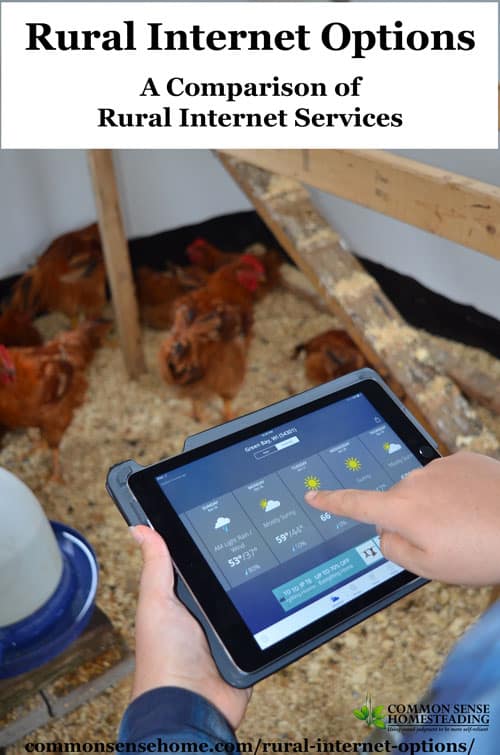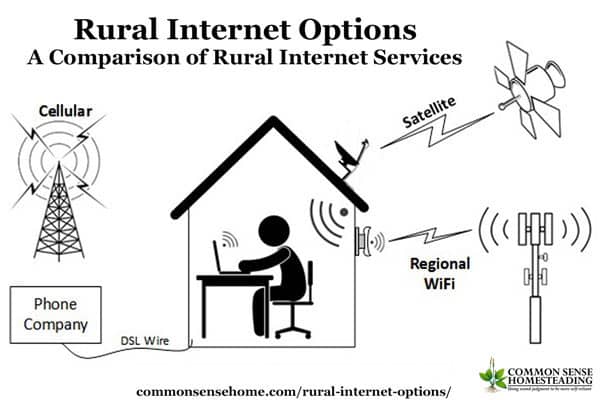Rural Internet Options – A Comparison of Rural Internet Services was first published on Total Survival
Living in the country has its benefits – lower cost per acre, fewer regulations and more freedom. But with those benefits comes a distinct disadvantage – slow or no rural internet options. Fast rural internet can be like looking for a unicorn, but for the homesteading commuter, farmer or rural entrepreneur, high speed rural internet access can be a necessity.
Research any internet provider before you commit. Choose cable if you can get it. Select DSL second, then cellphone MiFi or hotspot. Satellite and local point to point services are your 3rd option – pick whichever is the better price, speed and value. Remember to check with local power utilities and local government to see if there are unique options.
5 Rural Internet OptionsThere are four rural internet options when you live far out in the country:
- Cable – unlikely but check to make sure
- DSL – CenturyLink and other landline phone providers generally have at least slow DSL available
- Cellular – a MiFi (or hotspot) with unlimited data may be a bit pricey but it will get you access
- Satellite – download limits and high prices, make this the last option
- Check for Regional/Local Services
It is possible you may have other rural high speed internet options. Some communities created co-ops that provide DSL, regional WiFi or even municipal fiber networks. Some folks drive to a local library, fast food restaurant or other public internet access location for temporary high speed access. Avoid satellite if you can, they know they are a provider of last choice – so their service and support is poor even compared to cable and phone DSL services.
When looking for high speed internet for rural areas, try negotiating a test period for a link. Ask for ALL associated costs, fees, support costs and charges. Try to find someone who is using the service and ask how they like it. If you live in the country you will likely have trouble streaming YouTube, NetFlix or Amazon video and may not be able to make reliable voice/video internet access. Avoid any devices or services that use data (bandwidth) indiscriminately, such as “helpers” like the Echo Dot or internet connected appliances. These can tie up your connection or max out your available downloa very quickly.
Summary of Internet for Rural Areas
| Latency | Country | Stability | Cost per GB | |
|---|---|---|---|---|
| Cable Internet | Good to Great | Ok to Great | Ok to Great | $ |
| Phone Company DSL | Poor to Good | Ok to Great | Ok to Great | $ |
| Cellular Internet | Poor to Good | Poor to Good | Poor to Great | $$$ |
| Satellite – worst | Poor to Good | Terrible to Ok | Terrible to Ok | $$$ |
**satisfaction for services vary by location and provider – research locally before investing
Some Widely Available Rural Internet Providers
- Earthlink http://www.earthlink.net provides satellite, and wireless internet in limited areas
- HughesNet https://www.hughesnet.com/get-started (satellite)
- AT&T https://www.att.com/internet/fixed-wireless.html (point to point wireless)
- Exede https://www.exede.com/ (satellite) – basically the same as WildBlue
- Dish https://www.dish.com/internet/ (satellite)
- Google Fi https://fi.google.com/about/ (cellular)
Other internet service options could include internet provided by local municipalities, local power companies or even co-ops. Internet options for rural areas can vary widely, so do your research before jumping to satellite.
3 Main Factors that Affect Internet PerformanceInternet performance for each of the four sources is based on three factors: Speed (Bandwidth), Latency (Lag) and Stability (packet loss). Each factor impacts performance in a different way.
Speed
Higher numbers are better. Speed affects the amount of time to transfer large files. The technical term is bandwidth, because it is technically a combination of speed and amount of data transferred per second. Speed or bandwidth is measured in Mbps (or mega bits per second).
Upload and Download speeds will be different. Upload is normally 5x to 20x slower than download speeds.
A rough analogy is that Mbps is comparable to miles per hour (mph). Most service providers will list internet speed as “up to ##Mbps” – they will generally not guarantee the highest speed. We (and other friends on rural internet) rarely see anywhere close to the maximum possible speed theoretically available for our link. If possible, have your rural internet service provider do a speed test before you commit to a long term contract, so you know what you're getting.
Latency
Lower numbers are better. Latency affects response time. High latency can make a Skype or Google hangout call intermittent or choppy or fail altogether. If latency is low you generally get better quality realtime voice/video. Latency also is a big factor in online gaming. Latency or lag is a measure of the delay for a communications link.
A link can have 100Mbps high speed and 1000ms high latency. A simple analogy would be a highway that permits up to 100 miles per hour, but with 1000 second delay on the on and off ramps to the highway (fast on the highway and slow on/off). So every time you start to use your link, you start accessing, but there's a delay getting on.
A different link might be 100Mbps and 1ms latency, which would be like a 100 miles per hour and on/off ramps would be only 1 second (fast on the highway and fast on/off). When you use this link, you won't have a significant wait time to get going. Latency applies to uploads and downloads equally (it affects all information flowing to and from the internet).
Stability
Stability affects overall connectivity. A very busy service may have inconsistent service, like a road with bumper to bumper or stop and go traffic. A technical term that describes poor stability is “packet loss”. Zero or low packet loss is preferred.
Inconsistent service means the link stops working for periods of time causing perceived slowness, disconnects in voice/video calls, disconnects in games or lost sessions in online editing tools. So consistency of speed and latency both matter.
A very stable or consistent connection is more reliable and service is more predictable. Stability is a problem generally when a link is overloaded or “saturated”. This can occur due to the internet service provider oversubscribing – i.e. selling more bandwidth to each individual than they have in total. We see this regularly on our connection. During the day, when many people are at work, the connection is more stable. In the evening, when more people are home and using the service, it becomes difficult (if not impossible) to do things like stream a movie or youtube video.
Using Two Internet Connections at Once
We have a local provider that provides a dish that points to a nearby tower that gives us internet. The service is a point to point wireless internet connection, which is marketed as “wireless DSL”. Because we run an online business, we also have a phone company DSL connection, which is slower but more stable with lower latency. Sometimes one connection drops completely (sometimes both), but this gives us better odds of connecting. We have software and equipment that we manually use to switch between connections. There are options for a router to connect to two different connections.
Piggybacking Off a Better Connection
If you are techie and have line of sight to someone else who has good internet, you can get a point to point wireless connection and make a deal with them to share their internet or even get a 2nd internet connection at the address that can get the good internet.
Satellite Rural Internet
Solution: Compare the current rates and speeds, select the one that meets your needs. Call them and get the service installed.
Pros: It's available nearly everywhere, as it completely removes ground-based “line of sight” from the equation.
Cons: Moderate to expensive. Upload speeds rarely meet the maximums listed. Satellite service can vary dramatically depending on your tree-cover, weather, and latitude and longitude. Satellite regularly has a fixed upload and download speed, and a maximum upload/download amount. If you exceed the amount the link performance is reduced.
DSL and Cable Rural Internet
Solution: Call the cable or cellular provider and get the line installed.
Pros: Faster, more reliable, lower latency and less expensive.
Cons: DSL and Cable are very dependent on distance to the nearest service point. The closer you are the more speed options you will have and the better your service will be.
Cellular Rural Internet
Solution 1: Get an unlimited data plan for your family. Then buy a MiFi unit on the same plan (not all carries allow this). The MiFi unit converts the smartphone data feed to a WiFi signal for your apartment or home. This gives you portable WiFi. It won't be as good as a landline.
Solution 2: Get an unlimited data plan for your family. Then buy an extra backup cellphone on the same unlimited plan and leave it plugged in all the time, and acting as a hotspot. This gives you portable WiFi. It probably won't be as good as a MiFi.
Pros: Portable. Data speeds can be decent even when everything else is slow. Widely available. If you move, it can move with you.
Cons: Price can be moderate to high. Nearly all cellular internet services have data caps. This means that if you exceed the amount of data transferred, your cellular link performance is reduced until the next billing period.
Cellular Signal Note: Cellular is dependent on how close the cell towers are and your effective “line of sight” to those towers. If you have a metal roof, concrete home or metal siding it can reduce or block the signal from cellular internet services. You can get external cellular boosters that relay the cellular signal from inside your house to the nearest cellular tower.
How do I find Internet Service Near Me?
As you probably know, it is hard to find unlimited high speed internet for rural areas. Below is a list of resources that will help you find internet service options in your area.
Note: Maps are not 100% accurate. We've found several services that should be available at our home according to the map, but when we called the internet service providers it turned out that the service stopped on the other side of a nearby highway. In other cases, trees are between us and the nearest towers. The connection should work according to the map, but the trees cause interference.
- BroadbandNow https://broadbandnow.com/Fixed-Wireless -enter your zip to find services
- RVInternet https://www.rvmobileinternet.com/featured/ -information on various mobile internet options
- Best Internet Service Providers https://www.reviews.com/internet-service-providers/
- National BroadBand Speed Map: https://www.broadbandmap.gov/speed – some are out of date
- FCC Maps https://www.fcc.gov/reports-research/maps/ – some are out of date
Many states also have a broadband or high speed internet service provider maps. Also consider asking your local electric power provider and/or local government about high speed internet options.
Making it work!
Modern homesteading is often a mix of old and new. You'll find solar electric panels sitting next to a pile of wood for the stove, printed “how to” manuals used right alongside youtube videos to learn a new skill, and quiet country living paired with virtual friendships around the world. At Common Sense Home, we work to bring you a range of information so you can pick the options that work best for you.
Do you have a rural technology, home business, green building or preparedness question? Leave a comment and share your thoughts.
Related articles may also find useful:
Internet Security – 12 Steps to Avoid Computer Viruses and Identity Theft
Sole Proprietorship vs LLC – Are all Your Eggs in One Basket?
Electromagnetic Pulse (EMP) – What You Need to Know
 This post was written by August Neverman IV. August is the Chief Information Officer and Information Security Officer of Brown County. He's served on several emergency preparedness teams during his tenure at a local hospital, as well as undergoing emergency response training during his time with the Air National Guard. He and his wife, Laurie, live with their two sons in a Green Built, Energy Star certified home with a permaculture twist.
This post was written by August Neverman IV. August is the Chief Information Officer and Information Security Officer of Brown County. He's served on several emergency preparedness teams during his tenure at a local hospital, as well as undergoing emergency response training during his time with the Air National Guard. He and his wife, Laurie, live with their two sons in a Green Built, Energy Star certified home with a permaculture twist.
The post Rural Internet Options – A Comparison of Rural Internet Services appeared first on Common Sense Home.
This Article Was Originally Posted at commonsensehome.com Read The Original Article Herecheck out the full article Here: Rural Internet Options – A Comparison of Rural Internet Services


No comments:
Post a Comment